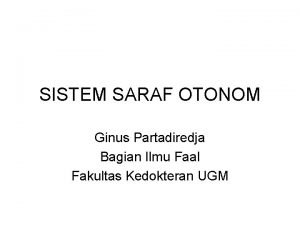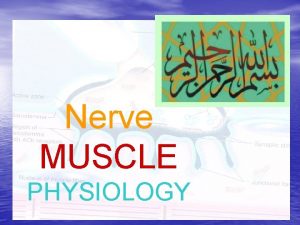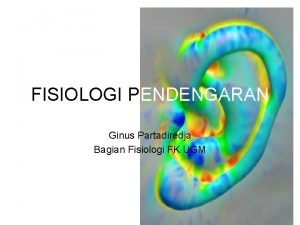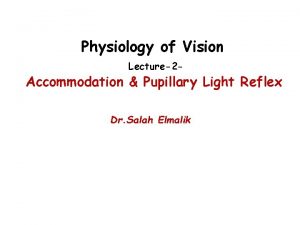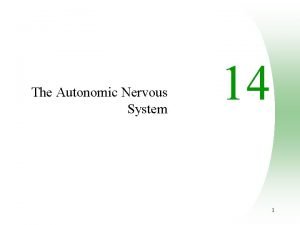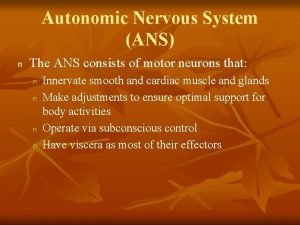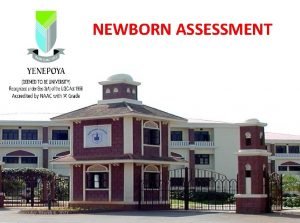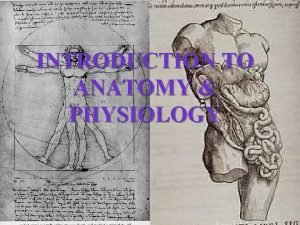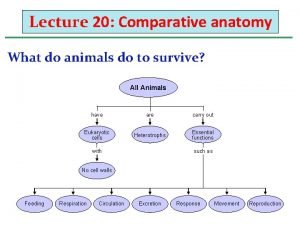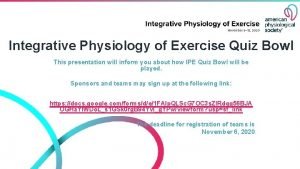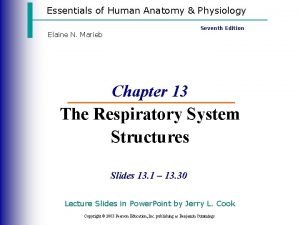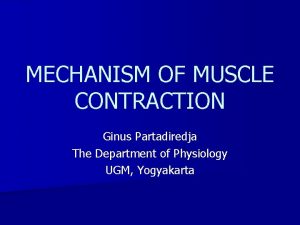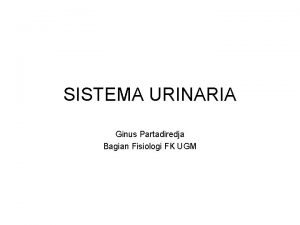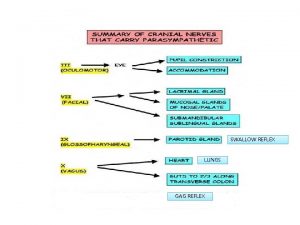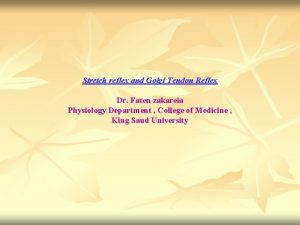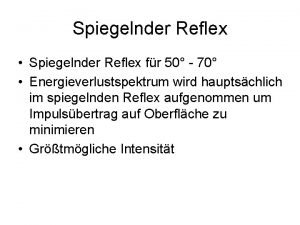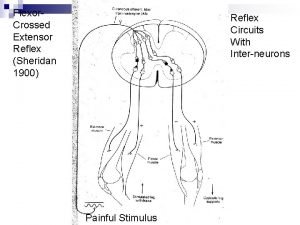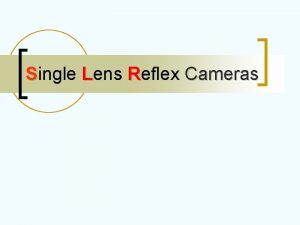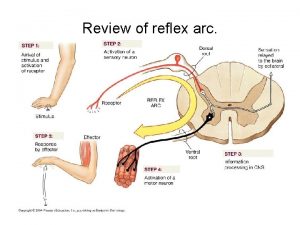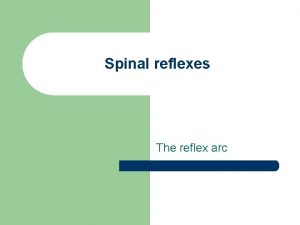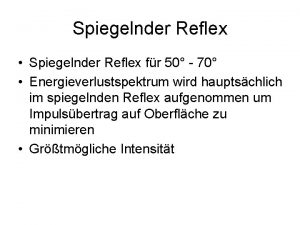REFLEX Ginus Partadiredja Department of Physiology REFLEX A


















- Slides: 18

REFLEX Ginus Partadiredja Department of Physiology

REFLEX: A Fast, automatic, predictable involuntary response to a particular stimulus REFLEX: - Inborn (pulling hand away from a hot surface) - Acquired (Driving expertise) REFLEX: 1. Somatic (skeletal muscle) 2. Autonomic (glands, cardiac & smooth muscle) REFLEX: 1. Spinal reflex 2. Cranial reflex

REFLEX ARC COMPONENTS: Sensory receptor Sensory/ afferent neuron Integrating center Motor/ Efferent neuron Effector REFLEX: 1. Monosynaptic reflex (e. g. stretch reflex) 2. Polysynaptic reflex (e. g. withdrawal reflex)

SOMATIC SPINAL REFLEXES 1. 2. 3. 4. Stretch reflex Tendon reflex Flexor (withdrawal reflex) Crossed extensor reflex 1. STRETCH (MYOTATIC) REFLEX - Control muscle length muscle contraction response Monosynaptic reflex Tapping tendons at the elbow (biceps & triceps reflexes), wrist, knee (knee jerk/ patellar reflex), ankle (Achilles reflex)

Biceps reflex Triceps reflex Achilles reflex Patellar reflex

PATELLAR REFLEX: Tendon Muscle spindle Ia afferent neuron Spinal cord motor neuron excited - Monosynaptic, ipsilateral reflex - Reciprocal innervation polysynaptic antagonistic muscle inhibited



MUSCLES: 1. Extrafusal 2. Intrafusal (muscle spindle) fibres MUSCLE SPINDLE: 1. Nuclear bag fibre 2. Nuclear chain fibre SENSORY NEURONS: 1. Nuclear bag fibre Ia afferent fibres 2. Nuclear chain fibre Ia and II afferent fibres MOTOR NEURONS: 1. Extrafusal fibres Alpha motor neuron 2. Intrafusal fibres Gamma motor neuron

• Nuclear bag fibres dynamic stretch reflex stretch • Nuclear chain fibres static stretch reflex GAMMA MOTOR NEURON: - Regulated by the brain, voluntary - Smooth out the movement during muscle contractions - Preventing jerky movements - Alpha & gamma motor neurons are stimulated simultaneously

2. TENDON REFLEX - Control muscle tension muscle relaxation response - Polysynaptic, ipsilateral - Golgi tendon organs Ib afferent neuron Spinal cord a. Inhibitory interneuron Motor neuron inhibited/ muscle relaxes b. Excitatory interneuron Motor neuron excited/ antagonistic muscle contracts


3. FLEXOR REFLEX - Withdrawal reflex - Polysynaptic, ipsilateral, intersegmental - Pain receptor Sensory neuron Integrating center Interneuron Motor neuron Ipsilateral flexor muscles - Reciprocal innervation extensor muscles

WITHDRAWAL REFLEX: - Polysynaptic - Ipsilateral - Intersegmental

4. CROSSED EXTENSOR REFLEX - Polysynaptic, contralateral, intersegmental - Contralateral reflex arc - Pain receptor Sensory neuron Integrating center Interneuron Motor neuron Contralateral extensor muscles - Reciprocal innervation Flexor muscles

DIAGNOSTICS 1. Muscle tone - Poliomyelitis hypotonia/ atonia - Stroke hypertonia - Muscle spasm (broken bone, peritonitis), cramps 2. Reflex - Afferent fibers/ lower motor neuron lesions (e. g. poliomyelitis, diabetes, syphilis) hyporeflexia - Descending motor pathways from the brain (e. g. stroke) hyperreflexia - Mass reflex

3. Patellar reflex Diabetes mellitus, neurosyphilis decrease/ absent Motor tracts descending from the brain disorders increase/ hyperreflexia 4. Achilles reflex Diabetes mellitus, neurosyphilis, alcoholism, subarachnoid hemorrhages decrease/ absent Cervical cord compression, motor tracts lesion increase 5. Abdominal reflex 6. Pupillary light reflex (autonomic reflex) brain injury indicator 7. Babinski sign

References • Carola R, Harley JP, Noback, CR (1990). Human Anatomy and Physiology, Chapter 12, Pages: 346 -450. • Ganong WF (2005). Review of Medical Physiology, 22 nd ed. Chapter 6, Pages: 129137. • Guyton AC & Hall JE (2006). Textbook of Medical Physiology, 11 th ed. Chapter 54, Pages: 673 -684. • Tortora GJ & Derrickson B (2006). Principles of Anatomy and Physiology, 11 th ed. Chapter 13, Pages: 460 -467.
 Interoseptor
Interoseptor Osmolaritas adalah
Osmolaritas adalah Sarcoplasmic reticulum
Sarcoplasmic reticulum Fisiologi pendengaran
Fisiologi pendengaran Mechanism of accomodation
Mechanism of accomodation Prevertebral ganglia
Prevertebral ganglia Somatic reflex vs visceral reflex
Somatic reflex vs visceral reflex Parachute reflex
Parachute reflex Tattoo anatomy and physiology
Tattoo anatomy and physiology Anatomy and physiology
Anatomy and physiology Gi tract histology
Gi tract histology The central sulcus divides which two lobes? (figure 14-13)
The central sulcus divides which two lobes? (figure 14-13) Unit 26 agriscience
Unit 26 agriscience Chapter 2 human reproductive anatomy and physiology
Chapter 2 human reproductive anatomy and physiology Physiology of sport and exercise 5th edition
Physiology of sport and exercise 5th edition Invertebrate digestive system
Invertebrate digestive system Exercise physiology quiz
Exercise physiology quiz Chapter 6 general anatomy and physiology
Chapter 6 general anatomy and physiology Anatomy and physiology
Anatomy and physiology
